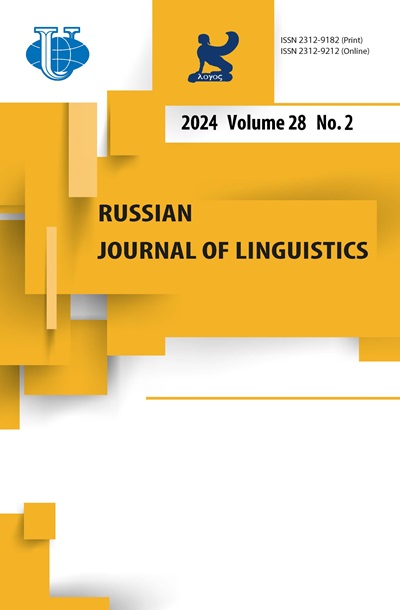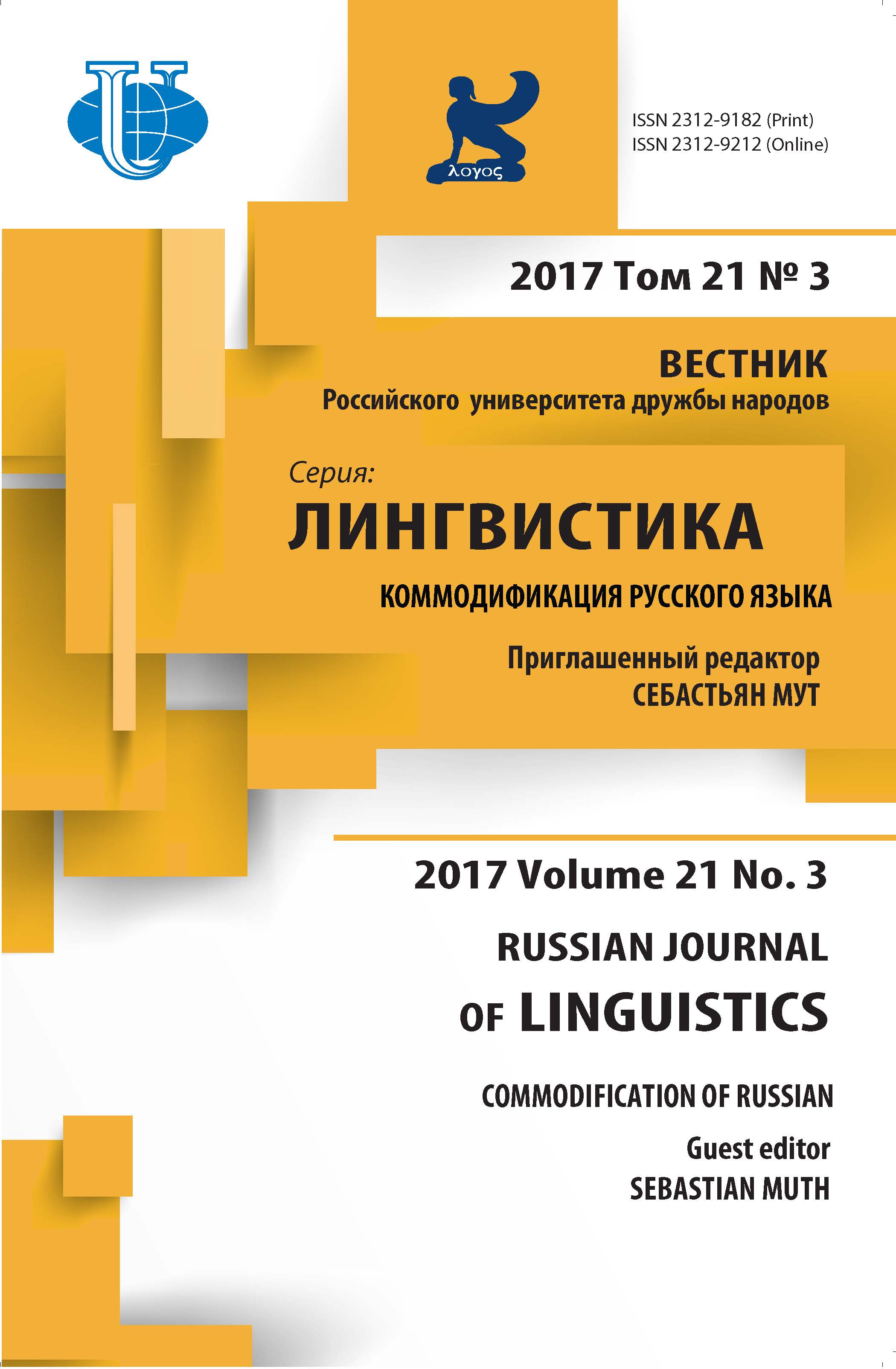ЯЗЫКОВОЙ ЛАНДШАФТ: ЧТО ОН НАМ ГОВОРИТ ОБ ИНТЕГРАЦИИ РУССКОГО ЯЗЫКА В ЭКОНОМИКУ ИЗРАИЛЯ
- Авторы: Еленевская М.1, Фиалкова Л.2
-
Учреждения:
- Политехнический институт Израиля
- Университет Хайфы
- Выпуск: Том 21, № 3 (2017): Коммодификация русского языка
- Страницы: 557-586
- Раздел: Статьи
- URL: https://journals.rudn.ru/linguistics/article/view/16791
- DOI: https://doi.org/10.22363/2312-9182-2017-21-3-557-586
Цитировать
Полный текст
Аннотация
Ключевые слова
Об авторах
Мария Еленевская
Политехнический институт Израиля
Email: ymaria52@technion.ac.ie
Мария Еленевская, доктор филологических наук, заведующая лабораторией по использованию компьютерных технологий в обучении иностранным языкам на кафедре гуманитарных наук в Политехническом институте Израиля. Сфера научных интересов: функционирование языка в многоязычном и многокультурном обществе, лингвокультурные особенности интернет-коммуникации, а также исследования юмора. Technion City, 3200003 Haifa, Israel
Лариса Фиалкова
Университет Хайфы
Email: lara@research.haifa.ac.il
Лариса Фиалкова, кандидат филологических наук, преподаватель кафедры ивритской и сравнительной литературы в Университете Хайфы. Сфера научных интересов: русская литература, славянский и современный фольклор. Она подготовила и читает различные курсы, среди которых: «Фольклор и иммиграция», «Фольклор в эпоху высоких технологий», «Образ чужака в фольклоре» и т.д. Ave. Abakhoushy Mount Carmel, 3498838 Haifa, Israel
Список литературы
- Abousnnouga, G., & Machin, D. (2010) War monuments and the changing discourses of war and soldiery. In Jaworski, A., & Thurlow, C. (eds.), Semiotic Landscapes: Language, Image, Space. London, New York: Continuum, 219-240.
- Aronin, L., & O. Laoire, M. (2013) The material culture of multilingualism: Moving beyond the lin¬guistic landscape. International Journal of Multilingualism, 10(3): 225-235.
- Backhaus, P. (2007) Linguistic Landscape: A Comparative Study of Multilingualism in Tokyo. Clevedon: Multilingual Matters.
- Barni, M., & Bagna, C. (2010) Linguistic Landscape and Language Vitality. In Ben-Rafael, E., Shoha¬my, E., & Barni, M. (eds.) Linguistic Landscape in the City. Clevedon, Buffalo, Toronto: Mul¬tilingual Matters, 3-18.
- Ben Rafael, E., Shohamy, E., Amara M., & Trumper-Hecht, N. (2006) Linguistic Landscape as Symbo¬lic Construction of the Public Space: The Case of Israel. In Gorter, D. (ed.), Linguistic Lands¬cape: A New Approach in Multilingualism. Clevedon, Buffalo, Toronto: Multilingual Matters, 7-30.
- Ben Rafael, E., & Ben Rafael, M. (2010) Diaspora and returning diaspora: French-Hebrew and vice versa. In Shohamy, E., Ben Rafael, E., & Barni, M. (2010) Linguistic Landscape in the City. Bristol, Buffalo, Toronto: Multilingual Matters, 326-343.
- Coupland, N. (2010) Welsh linguistic landscapes “from above” and “from below”. In Jaworski, A., & Thurlow, C. (eds.). Semiotic Landscapes: Language, Image, Space. London, New York: Con-tinuum, 77-101.
- Deutch, Y. (2005). Language law in Israel. Language Policy, 4: 261-285.
- Elias, N., & Greenspan, L. (2007). The honey, the bear and the violin: Russian voices in Israeli advert¬ising. Journal of Advertising Research, 47(1): 113-122.
- Fialkova, L. (1999) Russkii yazyk v Izrail’skoi torgovle. Yazyk emigrantov v svete sotsiolingvistiki (The Russian Language in Israel’s retailing, in Russian), Russistika segodnya, 1-2: 80-89.
- Fialkova, L. (2007) Koly Hory Shkodiat’sia: Narysy z Ukrain’sko-izrail’skykh Fol’klornykh Vzemyn (When Mountains Meet: Essays in Ukrainian-Israeli Folklore, in Ukrainian.) Kyiv: Institute of Art Studies, Folklore and Ethnology, Ukrainian Academy of Sciences.
- Fialkova, L., & Yelenevskaya, M. (2011) Immigrants in the City: From Exploration to Domestication, Israel Affairs, 17 (1): 143-164.
- Fialkova, L., & Yelenevskaya, M. (2013) In Search of the Self: Immigrants’: Reconciling the Past and the Present in Immigrants’ Experience. Tartu: ELM Scholarly Press.
- Fialkova, L., & Yelenevskaya, M. (2013a) Liubimyi prazdnik: Novyi god v emigrantskoi srede v Izraile (Our Favorite Holiday: New Year Celebrations among Immigrants to Israel, in Russian). In L. Fedorova (ed.), Ritual v yazyke i kommunikatsii, Moscow: JSK-RGGU, 255-265.
- Fialkova, L., & Yelenevskaya, M. (2015) The Crisis in Ukraine and the Split of Identity in the Russian-speaking World. Folklorica, XIX: 101-132.
- Glinert, L.H. (1995) Inside the language planner’s head: Tactical responses to a mass immigration. Journal of Multilingual and Multicultural Development, 16(5): 351-371.
- Golan-Cook, P., & Olshtain, E. (2011) A model of identity and language orientation: The case of im¬migrant students from the former Soviet Union in Israel. Journal of Multilingual and Multicul¬tural Development, 32(4): 361-376.
- Gorter, D. (2006) Introduction: The Study of linguistic landscape as a new approach to multilingualism. In Gorter, D. (ed.), Linguistic Landscape: A New Approach in Multilingualism. Clevedon, Buf¬falo, Toronto: Multilingual Matters, 1-6.
- Jaworski, A., & Thurlow, C. (2010) Introducing Semiotic Landscapes. In Jaworski, A., & Thurlow, C. (eds.), Semiotic Landscapes: Language, Image, Space. London, New York: Continuum, 1-40.
- Kelly-Holmes, H. (2005) Advertising as Multilingual Communication. New York: Palgrave Macmillan.
- Kheimets, N., & Epstein, A. (2001) English as a central component of success in the professional and social integration of scientists from the former Soviet Union in Israel. Language and Society, 30(2): 121-143.
- Khvorostianova, N., & Elias, N. (2008) Staryi dom na novoi ulitse? Kul’turnye instituty “russkoi ob¬schiny Ber-Shevy (An old home in a new street? Cultural institutions of the “Russian” Commu-nity in Beer-Sheva, in Russian.) In Nosenko, E. (ed.) Israil’ glazami “russkikh”: Kul’tura i iden¬tichnost’. Moscow: Natalis, 304-328.
- Kliuchnikova, P. (2015) Language attitudes and “folk linguistics” of Russian-speaking migrants in the UK. Russian Journal of Communication, 7(2): 179-192.
- Kopeliovich, Sh. (2013) “Happylingual”: A family project for enhancing and balancing multilingual development. In Schwartz, M., & Verschik, A. (eds.), Successful Family Language Policy: Parents, Children and Educators in Interaction. Dordrecht, Heidelberg, New York, London: Springer, 249-276.
- Landry, R., & Bourhis, R.Y. (1997) Linguistic landscape and ethnolinguistic vitality: An empirical study. Journal of Language and Social Psychology 16, 23-49.
- Lewis, M. P., Simons, G. F., Fenning, C. D. (eds.) (2016) Ethnologue: Languages of the World, 19th edition. Dallas, Texas: SIL International. Online version: http://www.ethnologue.com, last accessed 15 Sept. 2016.
- Marten, H. F., Mensel, L.Van, & Gorterm D. (2012) Studying minority languages in the linguistic landscape. In Gorter, D., Marten, H. F., & Mensel, L. van (eds.), Minority Languages in the Lin¬guistic Landscape. New York: Palgrave Macmillan, 1-18. Buffalo, Toronto: Multilingual Matters, 182-198.
- Mustajoki, A., & Protassova, E. (2014) Russkii sredi drugikh yazykov Finliandii: Aktual’nye problemi (Russian among other languages of Finland: Current Problems, in Russian) In Gasparov, B.M., & Kupina, N.A. (eds.), Russkii yazyk mnogorechnom sotsiokul’turnom prostranstve. Ekaterin¬burg: Ural University Press, 220-239.
- Nelde, P. (1987) Language contact means language conflict. Journal of Multilingual and Multicultural Development, 8(1-2): 33-42.
- Pavlenko, A. (2010) Linguistic landscape of Kyiv, Ukraine: A diachronic study. In Ben-Rafael, E., Shohamy, E., & Barni, M. (eds.) Linguistic Landscape in the City. Clevedon, Buffalo, Toronto: Multilingual Matters, 133-152.
- Pennycook, A. (2010) Graffscapes and city souls. In Jaworski, A., & Thurlow, C. (eds.), Semiotic Landscapes: Language, Image, Space. London, New York: Continuum, pp. 137-150.
- Perotto, M., & Niznik, M. - Перотто, М. и Низник, М. (2014) Po-russki govorim my s detstva. Iz opyta neformal’nogo obuchenia russkomu yazyku v Izraile i Italii. (We have been speaking Russian since childhood: On the experience of informal teaching of the Russian language in Israel and Italy, in Russian.) In Nikunlassi, A., & Protassova, E. (eds.) Slavica Helsingiensia, 5. Instrumentarium of Linguistics. Helsinki, 75-95.
- Remchukova, Е. (2015) Aktual’nye napravlenia sovremennoi rusistiki: sfera gorodskoi nominatsii kak ob’ekta lingvisticheskogo kreativa (Current trends in Russian studies: Name giving in in the city as an area of linguistic creativity, in Russian.) Russkii yazyk i literatura v prostranstve miro¬voi kul’tury. Proceedings of the 13th Congress of the International association of the teachers of Russian Language and literature, 8: 253-258.
- Remennick, L. (2008) «Russkie» izrail’tiane glazami sotsiologa: kul’tura i obraz zhizni (Cultural affiliation and lifestyles of Russian-speaking Israelis: A sociological view, in Russian.) In Nosen¬ko, E. (ed.), Israel through “Russian Eyes”: Identities and Cultures. Moscow: Natalis, 167-185.
- Schwartz, M., & Verschik, A. (2013) Achieving success in family language policy: Parents, children and educators in interaction. In Schwartz, M., & Verschik, A. (eds.), Successful Family Language Policy: Parents, Children and Educators in Interaction. Dordrecht, Heidelberg, New York, Lon¬don: Springer, 1-22.
- Shifman, L., Katz, E. (2005) “Just call me Adonai”: A case study of ethnic humor and immigrant assimilation. American Sociological Review, 70 (5), 843-859.
- Spolsky, Bernard (2001) Language in Israel: Policy, practice and ideology. In Alatis, J. E., & Tan, A.H. (eds.), Language in Our Time: Bilingual Education and Official English, Ebonics and Standard English, Immigration and the Unz Initiative. Washington D.C. George Town University Press, 164-174.
- Spolsky, B. (2009) Prolegomena to a sociolinguistic theory of public signage. In Shohamy, E., & Gor¬ter, D. (eds.), Linguistic Landscape: Expanding the Scenery. London: Routledge, pp. 25-38.
- Spolsky, B., & Cooper, R. (1991) Languages of Jerusalem. Oxford: Clarendon Press.
- Tolts, M. (2011) Demography of the contemporary Russian-speaking Jewish diaspora. Paper presented at the conference Contemporary Russian-speaking Jewish Diaspora, Harvard University, https://www.researchgate.net/publication/233985633_Demography_of_the_Contemporary_Russian-Speaking_Jewish_Diaspora, last accessed 27 May, 2017.
- Woldemariam, H., & Lanza, E. (2015) Imagined community: The linguistic landscape in a diaspora. Linguistic Landscape, 1 (1-2): 172-190.
- Yelenevskaya, M. (2015) An immigrant language in a multilingual state: Status and competition. Russian Journal of Communication, 7(2), pp. 193-207.
- Yelenevskaya, M., & Fialkova, L. (2005) Russkaia ulitsa v evreiskoi strane. Issledovanie fol’klora emigrantov 1990-kh v Izraile, v 2-kh tomakh (Russian street in the Jewish state. Research into the folklore of the emigrants of the 1990s in Israel, in Russian), 2 volumes. Moscow: Russian Academy of Sciences.
- Yelenevskaya, M. and Fialkova, L. (2006) Between dream cities and reality: Personal narratives of Ex-Soviets in Israel. Applied Research for the Quality of Life, No. 1, 189-209.
- Yelenevskaya, M., & Fialkova, L. (2012) “Holiday of Holidays” Festival in Haifa: Between Hope and Reality. Cultural Analysis, 10: 141-156, http://socrates.berkeley.edu/~caforum/volume10/ vol10_events2.html.
- Yuniverg, L. (2015) Russkoe knizhnoe delo v Izraile (Russian book industry in Israel, in Russian). Russkoe literaturnoe echo, http://www.eholit.ru/news/786/, last accessed 10 November 2016.
- Zbenovich, C., & Lerner, J. (2013) Vospitanie - eto rabota: Intercultural Encounters in educational communication within Russian-speaking families on Israel. Russian Journal of Communication, 5(2): 119-140.
- Zukin, S. (1998) Urban lifestyles: Diversity and standardization in spaces of consumption. Urban Studies, 35 (5/6): 825-839.

















